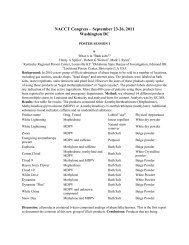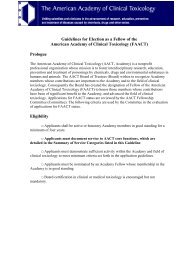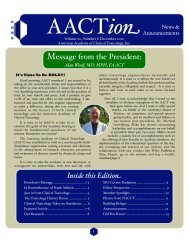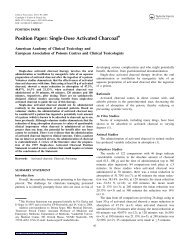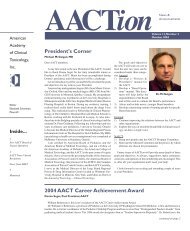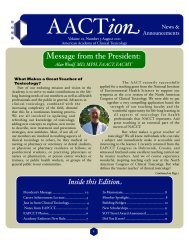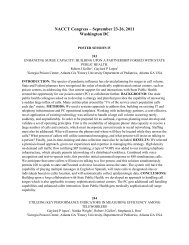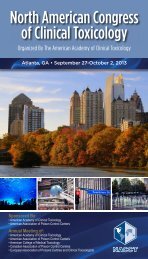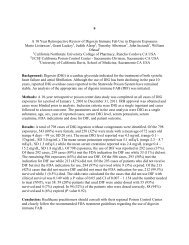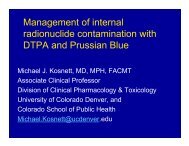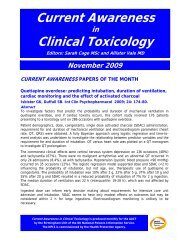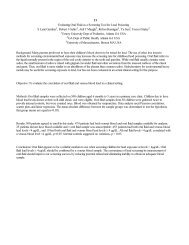NACCT Platform Abstracts 2012 - The American Academy of Clinical ...
NACCT Platform Abstracts 2012 - The American Academy of Clinical ...
NACCT Platform Abstracts 2012 - The American Academy of Clinical ...
Create successful ePaper yourself
Turn your PDF publications into a flip-book with our unique Google optimized e-Paper software.
6<br />
Incidents <strong>of</strong> Public Health Significance identified by National Surveillance <strong>of</strong> Poison Center Data<br />
Sophia Sheikh 1 , Royal Law 1 , Alvin Bronstein 2 , Richard Thomas 2 , Henry Spiller 2 , Joshua Schier 1<br />
1 Centers for Disease Control and Prevention, Atlanta GA USA<br />
2 <strong>American</strong> Association <strong>of</strong> Poison Control Centers<br />
<strong>The</strong> Centers for Disease Control and Prevention and the <strong>American</strong> Association <strong>of</strong> Poison Control Centers conduct public<br />
health surveillance on data collected by the National Poison Data System (NPDS) to identify incidents <strong>of</strong> public health<br />
significance (PHS). Automated surveillance algorithms run continuously in NPDS to identify instances when the number <strong>of</strong><br />
hourly calls to a PC (call volume incidents or CVIs), or the daily, cumulative count <strong>of</strong> any reported sign, symptom, or<br />
laboratory abnormality (clinical effect incidents or CEIs) exceed a historical baseline. Incidents are reviewed daily by clinical<br />
toxicologists and epidemiologists to determine if an incident is <strong>of</strong> PHS and if further public health action is needed. <strong>The</strong><br />
objective <strong>of</strong> this report is to characterize incidents <strong>of</strong> PHS identified by national surveillance from 1/2007 to 8/2011. Methods:<br />
All incidents <strong>of</strong> PHS identified from 1/1/2007 to 8/1/2011 were reviewed. PHS was left to the individual judgment <strong>of</strong> the<br />
surveillance team member. Outcome measures for CVIs included mechanism <strong>of</strong> chemical exposure, setting, and substance<br />
type: mechanism <strong>of</strong> chemical exposure, clinical syndrome, specific illness and substance reported was reported for CEIs.<br />
Results: A total <strong>of</strong> 830 CVIs were identified and the majority were <strong>of</strong> PHS (n=721; 86.9%). Airborne exposures (e.g., gases<br />
and fumes) were the most reported mechanism <strong>of</strong> chemical exposure for each year, and in total (n=312; 42.2%). <strong>The</strong> most<br />
common exposure setting for all years when combined was occupational (n=128, 27.9%), followed by school (n=126,<br />
27.5%). <strong>The</strong> most frequently reported chemical exposure every year was carbon monoxide (n=115, 15.5%), except in 2007<br />
(when an outbreak <strong>of</strong> Salmonella contaminated peanut butter occurred). A cumulative total <strong>of</strong> 383 CEIs were identified and<br />
the majority were <strong>of</strong> PHS (n=339; 88.5%). Airborne exposures were the most common mechanism <strong>of</strong> exposure for all years<br />
combined (70, 21.8%), followed by product contamination/tampering (68, 19.7%). <strong>The</strong> most common syndrome reported<br />
was gastrointestinal (n=124, 20.9%); diarrhea was the most frequently reported illness (n=42, 7.1%). Contaminated peanut<br />
butter (2007 and 2009 outbreaks) was the most frequently reported substance overall (n=61, 18%). Conclusions: Carbon<br />
monoxide releases were the most frequently reported incidents <strong>of</strong> PHS and gastrointestinal syndromes and symptoms were the<br />
most commonly reported illness manifestations. Surveillance <strong>of</strong> NPDS data can be used to characterize incidents <strong>of</strong> PHS and<br />
possibly identify risk factors for future interventions. <strong>The</strong>se surveillance strategies can be replicated at the regional level which<br />
would be <strong>of</strong> interest to state health departments.



